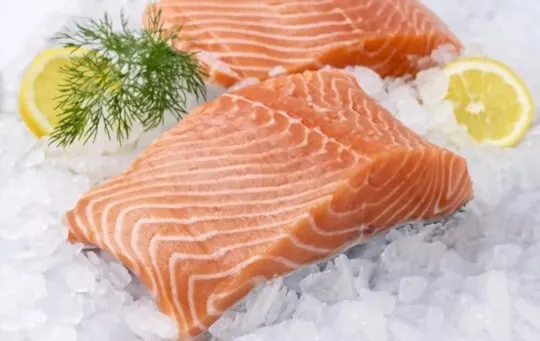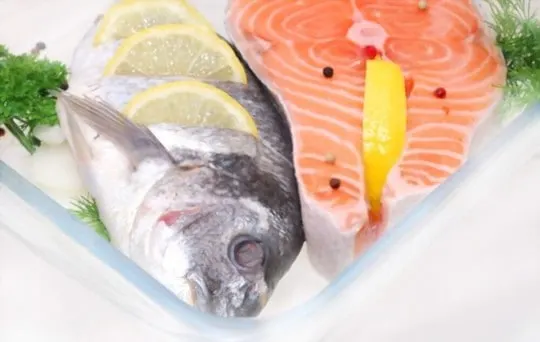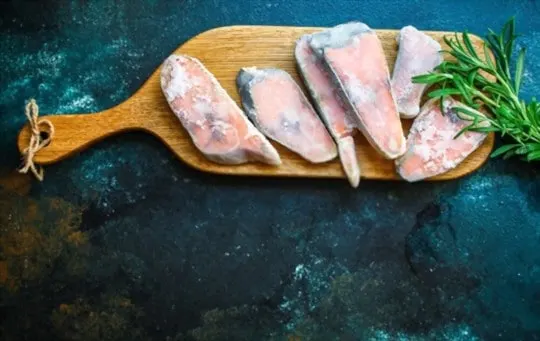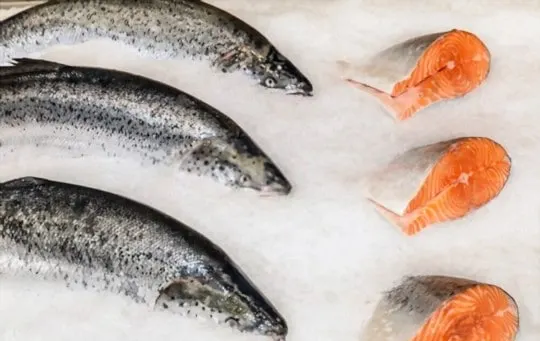Do you love salmon but hate the idea of cooking it from a frozen state? You’re not alone.
Many people have difficulty determining how to cook fish that is still in its very cold, hard form.
Fortunately, there are a few simple tricks for thawing and cooking this delicious protein-rich food.
Defrosting salmon filets is important to do correctly as it can affect the taste, quality and flavor of the fish.
How to Defrost Frozen Salmon without Ruining Taste

Defrosting frozen salmon can be difficult.
You must take care that the fish maintains its fresh flavor and does not spoil during this process.
Unlike other types of foods, salmon must not be defrosted by setting it on the counter.
Instead, other approaches are needed to ensure that frozen fish stays safe for consumption.
As a general rule of thumb, fully-thawed frozen salmon should be flexible and bendable.
Luckily there are a number of ways to safely defrost your fish at home.
Defrosting in your refrigerator, or using the microwave is one option among many others.
Whichever way you use, make sure to keep your hands clean and dry, avoid mixing different kinds of fish (especially raw and cooked), thoroughly cook it before eating, don’t forget about safety information listed by the EPA for frozen food handling.
Defrosting Salmon in the Refrigerator

After buying salmon from the store, you’ll find that most of it comes in plastic.
This is great for thawing as you can leave the fish inside its bag and let all the excess water drip out before cooking it.
After removing the fish from the freezer, place it in the fridge and do not leave it out on a countertop.
Some frozen seafood can become bad if left out at room temperature too long due to bacteria growth risks.
The temperature of the salmon is important because this affects how quickly you can defrost it.
Defrosting fish in the refrigerator will ensure that it stays cool and fresh.
But keep in mind how long salmon can be stored after its been thawed through.
You should expect to defrost a pound of fish for about four hours or more in the refrigerator.
The best way to defrost your salmon is to leave overnight, which should usually allow the food to thaw uniformly.
Eating spoiled fish may result in foodborne illnesses, and is especially risky if you are not careful.
If you leave your fish to thaw for too long, it will become tough and tasteless.
How to Use Microwave to Thaw Salmon

There are several different ways to go about defrosting salmon, but the microwave is by far the most convenient for those pressed for time.
If you are looking to thaw your salmon rapidly, then you will need to use this technique.
However, there are some things that you can do to ensure that it’s done correctly.
Lot of microwave owner manuals will provide instructions for defrosting salmon, but here is a basic technique:
- Select a microwaving setting that corresponds to your estimation of weight and enter in an appropriate time.
- Watch as it thaws, make sure you stop when it has become bendable, but before all of this icy clear liquid seeps out or melts away completely. This will enable you to easily cook the partially thawed fish after completing microwaving without washing away any flavor beforehand.
One good way to work out how long you will need to thaw your salmon is by checking the weight of the piece of fish.
However, you should still check on it from time to time so that no bad bacteria sets in and spoils it all.
It might also help to occasionally turn the salmon over during the defrosting process, which will guarantee a more uniform thaw.
Where it thaws unequally, this can make it tough to cook evenly.
Microwaves are a quick way to thaw salmon with no mess involved.
However, it’s important that you know the strength of your particular microwave so that the fish doesn’t dry out in the process.
If you like your yummy crispy crunchy salmon, then microwaving should only be done when absolutely necessary.
People typically use this method most often because it happens to be the fastest way to defrost but care must not be taken as overcooking will cook and damage the meat.
How to Defrost Salmon in Icy Water

If you need to defrost frozen salmon and do not have an electrical appliance, place the solidified fish in icy water for around an hour.
Here’s how:
Place the frozen salmon in a large bowl of ice water.
You can also use an iced bathtub, sink or container.
The fish should be submerged for around one hour to defrost fully.
Fish that is not completely thawed may still have some internal frost, so it’s important to check before cooking and eating them.
During this time you’ll need to change out your icy water every 15 minutes or so because as the temperature rises from 32 degrees Fahrenheit (0 Celsius) up towards 40°F (-40°C), more ice will melt over the period of an hour than if left at one consistent temperature throughout that time interval.
Check the salmon periodically to ensure it has defrosted and is adequately softened.
Using icy water is an efficient means of thawing your fish.
Though it may take longer, the quality will be better than if the fish is thawed with warm water.
When you’re done, cook and eat your salmon.
Things to Avoid when Defrosting Salmon

To avoid cross-contamination when defrosting fish, make sure to wash hands before and after handling salmon.
Do not use the same kitchen utensils to serve raw or cooked salmon.
Put leftovers in refrigerator for no more than two days.
There are many different ways to defrost salmon.
Knowing how to do it correctly will help you cook perfect frozen salmon the next time you need a quick and healthy meal.
Can Salmon Be Cooked from Frozen?

As long as frozen salmon is cooked to a safe temperature, it can be a delicious meal.
If you don’t want tough and overcooked fish, be sure to cook it thoroughly.
One way is to place the salmon in a pan or cooking dish, and cover with aluminum foil before baking.
Most frozen fish will take about 15-20 minutes at 350 degrees Fahrenheit (177 Celsius).
You can also make use of an electric griddle by putting a layer of oil down first, then placing the fish on top.
Cooking times vary depending on thickness but most fillets should be done in around 12 minutes at 450 degrees Fahrenheit (232 Celsius).
How to Defrost Salmon to Eat Raw or Sushi

Salmon is a great fish for sushi, but what if you have some raw salmon left? Or maybe you like to eat it raw on its own, or with other vegetables.
The best way to defrost salmon is by thawing it in a glass dish and placing the dish in your refrigerator for about 12 hours.
You can also place the frozen fish directly on top of some lettuce leaves (or something similar) so that it doesn’t come into contact with anything moist until you’re ready to cook it – this will prevent any bacteria from growing while waiting for you to finish cooking everything else.
Some people like their salmon raw when they are serving sushi rolls; if you prefer your fish cold then put the wrapped roll back into its plastic bag once finished rolling and refrigerate straight away before slicing it.
How to Thaw Frozen Salmon Vacuum Sealed

Vacuum sealed frozen salmon is the perfect way to save space in your freezer.
But, when you want to thaw some out for dinner tonight or this weekend; use one of these easy methods:
- Place it in a bowl and cover with cool water. Change the water every 30 minutes or so to keep it from cooling down.
- Place a microwave-safe dish or bowl with water in it next to the salmon and cover tightly with plastic wrap, tucking the edges of the wrap under the edge of your freezer. Microwave on high for about five minutes.
Never leave frozen fish sitting at room temperature.
It could cause bacteria to grow leading to food poisoning when consumed later; even if cooked thoroughly.
Conclusion
Frozen salmon can be a great alternative to fresh, especially if you want the convenience of having tasty fish on hand without having to go through all the effort.
That said, it is important not to make any mistakes when thawing and cooking frozen salmon so that your dish turns out perfect every time.
Here are some tips for defrosting and cooking this type of seafood delicacy so that you never have an undercooked or burnt piece again.
Give it a try next time you need something quick and easy for dinner tonight.
